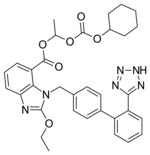Candesartan
 | |
| Clinical data | |
|---|---|
| Trade names | Atacand |
| AHFS/Drugs.com | Monograph |
| MedlinePlus | a601033 |
| Pregnancy category |
|
| Routes of administration | oral |
| ATC code | |
| Legal status | |
| Legal status | |
| Pharmacokinetic data | |
| Bioavailability | 15% (candesartan cilexetil) |
| Metabolism | Candesartan cilexetil: intestinal wall; candesartan: hepatic (CYP2C9) |
| Elimination half-life | 9 hours |
| Excretion | Renal 33%, faecal 67% |
| Identifiers | |
| |
| CAS Number | |
| PubChem CID | |
| IUPHAR/BPS | |
| DrugBank | |
| ChemSpider | |
| UNII | |
| KEGG | |
| ChEBI | |
| ChEMBL | |
| CompTox Dashboard (EPA) | |
| ECHA InfoCard | 100.132.654 |
| Chemical and physical data | |
| Formula | C24H20N6O3 |
| Molar mass | 440.45 g·mol−1 |
| 3D model (JSmol) | |
| |
| |
| | |
Candesartan (rINN) /ˌkænd[invalid input: 'ɨ']ˈsɑːrtən/ is an angiotensin II receptor antagonist used mainly for the treatment of hypertension. The prodrug candesartan cilexetil is marketed by AstraZeneca and Takeda Pharmaceuticals, commonly under the trade names Blopress, Atacand, Amias, and Ratacand.
Clinical use
As are all angiotensin II receptor antagonists, candesartan is indicated for the treatment of hypertension. Results from the CHARM study in the early 2000s demonstrated the morbidity and mortality reduction benefits of candesartan therapy in congestive heart failure.[2] Thus, while ACE inhibitors are still considered first-line therapy in heart failure, candesartan can be used in combination with an ACE to achieve improved mortality and morbidity vs. an ACE alone and additionally is an alternative in patients intolerant of ACE inhibitor therapy.
Prehypertension
In a four-year randomized controlled trial, candesartan was compared to placebo to see whether it could prevent or postpone the development of full-blown hypertension in people with so-called prehypertension. During the first two years of the trial, half of participants were given candesartan, and the others received placebo; candesartan reduced the risk of developing hypertension by nearly two-thirds during this period. In the last two years of the study, all participants were switched to placebo. By the end of the study, candesartan had significantly reduced the risk of hypertension, by more than 15%. Serious side effects were actually more common among participants receiving placebo than in those given candesartan.[3]
Combination with diuretic
Candesartan is also available in a combination formulation with a low dose thiazide diuretic, invariably hydrochlorothiazide, to achieve an additive antihypertensive effect. Candesartan/hydrochlorothiazide combination preparations are marketed under various trade names including Atacand HCT, Hytacand, Blopress Plus, Advantec and Ratacand Plus.

Chemistry and pharmacology
Candesartan is marketed as the cyclohexyl 1-hydroxyethyl carbonate (cilexetil) ester, known as candesartan cilexetil. Candesartan cilexetil is metabolised completely by esterases in the intestinal wall during absorption to the active candesartan moieity.
The use of a prodrug form increases the bioavailability of candesartan. Despite this, absolute bioavailability is relatively poor at 15% (candesartan cilexetil tablets) to 40% (candesartan cilexetil solution). Its IC50 is 15 µg/kg.
Synthesis
Candesartan is synthesised as follows:[4]
See also
References
- ^ "FDA-sourced list of all drugs with black box warnings (Use Download Full Results and View Query links.)". nctr-crs.fda.gov. FDA. Retrieved 22 Oct 2023.
- ^ Pfeffer M, Swedberg K, Granger C, Held P, McMurray J, Michelson E, Olofsson B, Ostergren J, Yusuf S, Pocock S (2003). "Effects of candesartan on mortality and morbidity in patients with chronic heart failure: the CHARM-Overall programme". Lancet. 362 (9386): 759–66. doi:10.1016/S0140-6736(03)14282-1. PMID 13678868.
{{cite journal}}: CS1 maint: multiple names: authors list (link) - ^ Julius S, Nesbitt SD, Egan BM; et al. (July 2006). "Feasibility of treating prehypertension with an angiotensin-receptor blocker". New England Journal of Medicine. 354 (16): 1685–97. doi:10.1056/NEJMoa060838. PMID 16537662.
{{cite journal}}: Explicit use of et al. in:|author=(help)CS1 maint: multiple names: authors list (link) - ^ Attention: This template ({{cite doi}}) is deprecated. To cite the publication identified by doi:10.1021/jm00067a016, please use {{cite journal}} (if it was published in a bona fide academic journal, otherwise {{cite report}} with
|doi=10.1021/jm00067a016instead.

